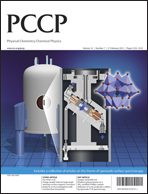Influence of electron correlation and degeneracy on the Fukui matrix and extension of frontier molecular orbital theory to correlated quantum chemical methods
Abstract
The Fukui function is considered as the diagonal element of the Fukui matrix in position space, where the Fukui matrix is the derivative of the one particle density


 Please wait while we load your content...
Please wait while we load your content...